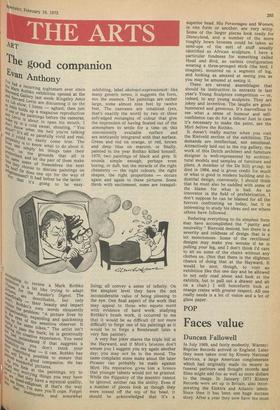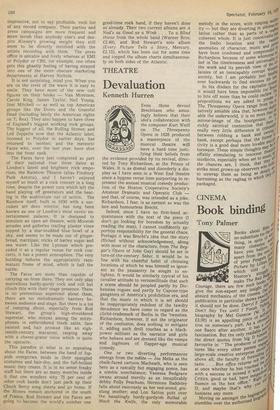POP
Faces value
Duncan Fallowell
In July 1969, and fairly modestly, Warner/ Reprise Records arrived in England. Later they were taken over by Kinney National Services, a large American conglomerate which had originally made its money in funeral parlours and thought records and films might add fun as well as more dollars to the image. In January 1971 Kinney Records were set up in Britain, also incorporating the Elektra and Atlantic labels. Since then it has been one huge success story. After a year they now have the most impressive, not to say profitable, rock list of any record company. Their parties and press campaigns are more frequent and more lavish than anybody else's and despite Kinney's growing weight they still seem to be directly involved with the artists recording with them. The press office is amiable and lively whereas at EMI or Polydor or CBS, for example, one often gets this ghastly feeling of having strayed into one of the more obscure marketing departments at Harvey Nichols.
It is not surprising, mind you. When you are on the crest of the wave it is easy to smile. They have most of the new cult figures on their books — Van Morrison, Carole King, James Taylor, Neil Young, Joni Mitchell — as well as top American groups like the Doors and the Grateful Dead (including lately the American rights on T, Rex). They also happen to have three of England's biggest working rock groups. The biggest of all, the Rolling Stones; and Led Zeppelin now that the Atlantic label, licensed to Polydor in earlier days, has returned to mother; and the meteoric Faces who, over the last year, have shot into the front rank.
The Faces have just completed as part of their national tour three dates at London's latest and brightest rock emporium, the Rainbow Theatre (alias Finsbury Park Astoria), and I haven't enjoyed myself so much at a rock concert in a long time, despite the power cuts which left the band playing off generators and the heating in the auditorium out of action. The Rainbow itself, built in 1930 with a succulent art deco interior, has long been known as one of London's most exotic entertainment palaces. It is designed to simulate an open air theatre, with Moorish arcades and galleries trailing plaster vines topped by a star-studded blue bowl of a sky, and seems to be made out of gingerbread, marzipan, sticks of barley sugar and sea water. Like the Lyceum which preceded it as a regular venue for rock concerts, it has a potent atmosphere. The very building induces the appropriately razzmatazz frame of mind, which is half the battle.
The Faces are more than capable of carrying on from there. They not only play marvellous hurdy-gurdy rock and roll but clinch this with their stage presence. There is no pretentious supercool about them, there are no melodramatic barriers between audience and stage. But there is a lot of camping about, especially from Rod Stewart, the group's high-shouldered superstar, who minces among the microphones in embroidered black satin, face painted and, hair prinked like an eighteenth-century macaroni, rasping away with a cheese-grater voice which is quite the opposite.
This paradox is what is so appealing about the Faces, between the band of fop pish overgrown mods in their spangled costumes and hair-dos, and the full-bellied music they create. It is in no sense freaky stuff but there are so many muscles inside it that one wonders why 75 per cent of other rock bands don't just pack up their Chuck Berry song sheets and go home. If the Stones remain anchored in the south of France. Rod Stewart and the Faces are going to become the world's number one good-time rock band, if they haven't done so already. Their two current albums are A Nod's as Good as a Wink . . . To a Blind Horse from the whole band (Warner Bros, £2.49), and Rod Stewart's solo album (Every Picture Tells a Story, Mercury, £2.15), which has been out for some time and topped the album charts simultaneously on both sides of the Atlantic.











































 Previous page
Previous page